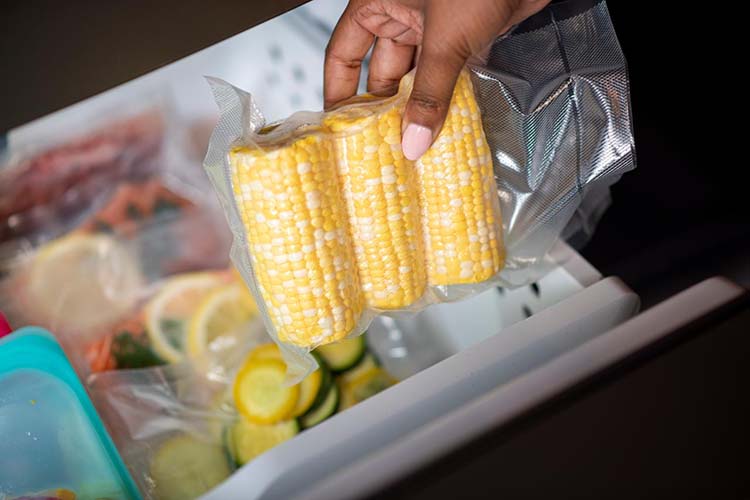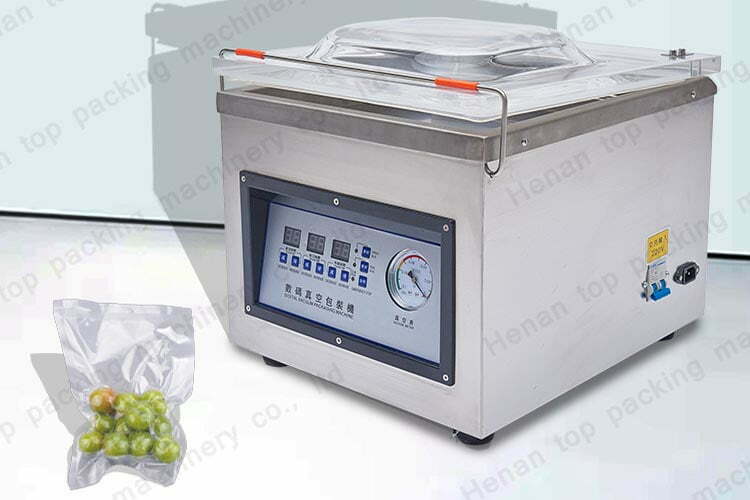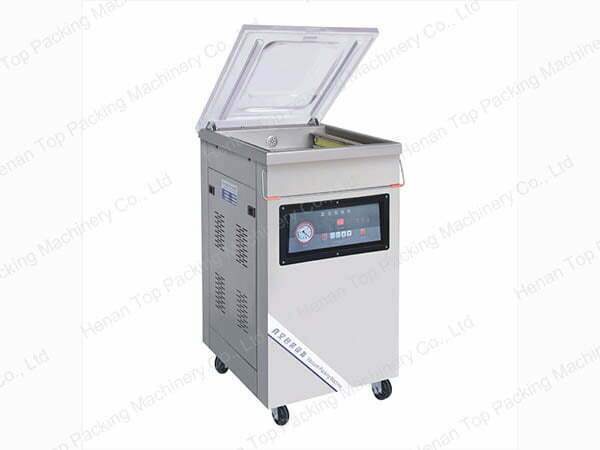ویکیوم پیکنگ مشین کا حتمی راز
ویکیوم پیکنگ مشین ایک ایسا آلہ ہے جو کسی پیکیج سے ہوا کو ہٹاتا ہے اور اس کے مواد کی تازگی اور لمبی عمر کو برقرار رکھنے کے لیے اسے سیل کرتا ہے۔ یہ مشینیں عام طور پر کھانے کی صنعت میں خراب ہونے والی مصنوعات کی شیلف لائف کو بڑھانے کے لیے استعمال ہوتی ہیں، لیکن ان کا استعمال مختلف صنعتوں میں غیر غذائی اشیاء کی حفاظت اور ذخیرہ کرنے کے لیے بھی کیا جاتا ہے۔

کیا پیکیجنگ مواد استعمال کیا جا سکتا ہے؟
ویکیوم پیکنگ مشینوں کو مختلف قسم کے پیکیجنگ مواد کے ساتھ استعمال کیا جا سکتا ہے، بشمول بیگ، پاؤچز اور فلم کے رول۔ ویکیوم پیکنگ کے عمل میں بیگ یا پاؤچ میں پیک کرنے والی چیز کو رکھنا، بیگ یا پاؤچ کو سیل کرنا، اور پھر ویکیوم پیکنگ مشین کا استعمال کرکے ہوا کو ہٹانا اور بیگ یا پاؤچ کو سیل کرنا شامل ہے۔ یہ ایک تنگ، ہوا سے بند مہر بناتا ہے جو مواد کی تازگی کو برقرار رکھنے اور انہیں نمی، آکسیجن اور بیکٹیریا جیسے بیرونی عوامل سے بچانے میں مدد کرتا ہے۔
ویکیوم پیکیجنگ مشین کی ایپلی کیشنز
کھانے کی صنعت میں ان کے استعمال کے علاوہ، ویکیوم پیکنگ مشینیں صحت کی دیکھ بھال، صنعتی اور خوردہ سمیت متعدد دیگر صنعتوں میں بھی استعمال ہوتی ہیں۔ وہ خاص طور پر ان اشیاء کو ذخیرہ کرنے کے لیے مفید ہیں جو درجہ حرارت، نمی، یا دیگر ماحولیاتی عوامل میں تبدیلیوں کے لیے حساس ہیں۔
ویکیوم پیکیجنگ مشینوں کی اقسام
ویکیوم پیکنگ مشینوں کی کئی اقسام ہیں، جن میں چیمبر مشینیں اور بیرونی سکشن مشینیں شامل ہیں۔ چیمبر مشینیں ویکیوم چیمبر کے اندر بیگ یا پاؤچ سے ہوا کو سیل اور نکالنے کے لیے ڈیزائن کی گئی ہیں۔ دوسری طرف، بیرونی سکشن مشینیں بیگ یا پاؤچ سے ہوا کو نکالنے کے لیے ہوز کا استعمال کرتی ہیں۔

ویکیوم پیک مشین کا کام کیا ہے؟
ویکیوم پیک مشین ایک ایسا آلہ ہے جو پیکیج سے ہوا کو ہٹاتا ہے اور مواد کی شیلف لائف کو بڑھانے کے لیے اسے سیل کرتا ہے۔ یہ اکثر خراب ہونے والی کھانے کی اشیاء، جیسے گوشت، مچھلی اور سبزیوں کے ساتھ ساتھ غیر خوراکی اشیاء، جیسے دستاویزات اور الیکٹرانکس کو ذخیرہ کرنے کے لیے استعمال ہوتا ہے۔
ویکیوم پیک مشین نلی یا ٹیوب کے ذریعے پیکیج سے ہوا کو چوس کر اور پھر ہیٹ سیل یا دوسری قسم کی بندش کے ساتھ پیکج کو سیل کر کے کام کرتی ہے۔ یہ عمل پیکیج کے اندر ایک خلا پیدا کرتا ہے، جو مائکروجنزموں کی نشوونما کو روک کر اور آکسیڈیشن کو روک کر مواد کے معیار اور تازگی کو برقرار رکھنے میں مدد کرتا ہے۔
ویکیوم پیک مشینیں مختلف سیٹنگز میں استعمال ہوتی ہیں، بشمول کمرشل کچن، گروسری اسٹورز اور گھر۔ ان کا استعمال مصنوعات کی ایک وسیع رینج کو پیک کرنے کے لیے کیا جا سکتا ہے، بشمول خشک سامان، مائعات، اور یہاں تک کہ گیس بھی۔ کچھ ویکیوم پیک مشینیں اضافی خصوصیات سے بھی لیس ہوتی ہیں، جیسے کھانے کو میرینیٹ کرنے کی صلاحیت یا مواد کے معیار کو برقرار رکھنے میں مدد کے لیے پیکیج میں گیس فلش شامل کرنا۔

کیا ویکیوم پیکنگ اس کے قابل ہے؟
مخصوص قسم کے کھانے اور دیگر اشیاء کی شیلف لائف کو بڑھانے کے لیے ویکیوم پیکنگ ایک مفید طریقہ ہو سکتا ہے۔ پیکیج سے ہوا کو ہٹا کر اور اسے سیل کر کے، ویکیوم پیکنگ مائکروجنزموں کی افزائش کو روکنے، آکسیڈیشن کو روکنے اور مواد کو طویل عرصے تک تازہ رکھنے میں مدد دیتی ہے۔
یہ فیصلہ کرتے وقت غور کرنے کے لیے کئی عوامل ہیں کہ آیا ویکیوم پیکنگ کسی خاص پروڈکٹ یا صورت حال کے لیے اس کے قابل ہے۔ غور کرنے کے لئے کچھ چیزیں شامل ہیں:
پروڈکٹ کی قسم: ویکیوم پیکنگ خراب ہونے والی اشیاء کے لیے سب سے زیادہ مؤثر ہے جو خرابی یا انحطاط کا شکار ہوتی ہیں، جیسے گوشت، مچھلی اور سبزیاں۔
ذخیرہ کرنے کی مدت: ویکیوم پیکنگ کچھ مصنوعات کی شیلف لائف بڑھانے میں مدد کر سکتی ہے، لیکن یہ مناسب ذخیرہ اندوزی اور ہینڈلنگ کا متبادل نہیں ہے۔ مثال کے طور پر، خراب ہونے سے بچنے کے لیے ویکیوم پیک شدہ گوشت کو اب بھی ریفریجریٹر یا فریزر میں رکھنا چاہیے۔
ویکیوم پیکنگ کی لاگت اور سہولت: ویکیوم پیک مشینیں اور بیگ نسبتاً مہنگے ہو سکتے ہیں، اس لیے ویکیوم پیکنگ کے ممکنہ فوائد کے مقابلے میں لاگت کا وزن کرنا ضروری ہے۔
مجموعی طور پر، ویکیوم پیکنگ بعض مصنوعات کے معیار اور تازگی کو برقرار رکھنے کے لیے ایک مفید طریقہ ہو سکتا ہے، لیکن یہ ہمیشہ ضروری یا سستا نہیں ہوتا ہے۔ اس بات کا تعین کرنے کے لیے کہ آیا ویکیوم پیکنگ اس کے قابل ہے یا نہیں، سوال میں مصنوعات کی مخصوص ضروریات اور حالات پر غور کرنا ضروری ہے۔
ویکیوم پیکنگ کے نقصانات کیا ہیں؟
ویکیوم پیکنگ کے استعمال کے کئی ممکنہ نقصانات ہیں:
لاگت: ویکیوم پیک مشینیں اور بیگ نسبتاً مہنگے ہو سکتے ہیں، خاص طور پر اگر آپ انہیں کثرت سے استعمال کرنے کا ارادہ رکھتے ہیں۔
محدود مطابقت: کچھ قسم کی مصنوعات ویکیوم پیکنگ کے لیے موزوں نہیں ہو سکتی ہیں، یا تو اس لیے کہ وہ بہت نازک ہیں یا اس لیے کہ وہ ویکیوم کے عمل سے خراب ہو جائیں گی۔
محدود شیلف لائف: اگرچہ ویکیوم پیکنگ کچھ مصنوعات کی شیلف لائف بڑھانے میں مدد کر سکتی ہے، لیکن یہ مناسب ذخیرہ اندوزی اور ہینڈلنگ کا متبادل نہیں ہے۔ مثال کے طور پر، خراب ہونے سے بچنے کے لیے ویکیوم پیک شدہ گوشت کو اب بھی ریفریجریٹر یا فریزر میں رکھنا چاہیے۔
محدود تاثیر: ویکیوم پیکنگ خراب ہونے والی اشیاء کے لیے سب سے زیادہ مؤثر ہے جو خرابی یا انحطاط کا شکار ہوتی ہیں، جیسے گوشت، مچھلی اور سبزیاں۔ یہ غیر خراب ہونے والی اشیاء یا پہلے سے اچھی طرح محفوظ مصنوعات کے لیے اتنا مؤثر نہیں ہو سکتا ہے۔
نقصان کا خطرہ: اگر ویکیوم پیک مشین کا صحیح طریقے سے استعمال نہ کیا جائے، یا اگر بیگ یا سیلز اچھے معیار کے نہ ہوں، تو پیکج کے مواد کو نقصان پہنچنے یا خراب ہونے کا خطرہ ہے۔
مجموعی طور پر، اگرچہ ویکیوم پیکنگ بعض مصنوعات کے معیار اور تازگی کو برقرار رکھنے کے لیے ایک مفید طریقہ ہو سکتا ہے، لیکن یہ ہمیشہ ضروری یا مناسب نہیں ہوتا ہے۔ یہ فیصلہ کرنے سے پہلے کہ آیا ویکیوم پیکنگ صحیح انتخاب ہے یا نہیں، سوال میں مصنوعات کی مخصوص ضروریات اور حالات پر غور کرنا ضروری ہے۔

ویکیوم سیل ہونے پر کون سے کھانے سب سے زیادہ دیر تک رہتے ہیں؟
ویکیوم سیلنگ مائکروجنزموں کی نشوونما کو روک کر اور آکسیڈیشن کو روک کر کچھ خاص قسم کے کھانے کی شیلف لائف کو بڑھانے میں مدد کر سکتی ہے۔ کچھ غذائیں جو ویکیوم سیل ہونے پر زیادہ دیر تک چلتی ہیں ان میں شامل ہیں:
گوشت: ویکیوم سیلنگ خام یا پکے ہوئے گوشت، بشمول گائے کا گوشت، سور کا گوشت، چکن اور میمنے کی کوالٹی اور تازگی کو برقرار رکھنے میں مدد کر سکتی ہے۔ ویکیوم سیل شدہ گوشت کو کوالٹی کھونے یا خراب ہوئے بغیر زیادہ عرصے تک ریفریجریٹر یا فریزر میں رکھا جا سکتا ہے۔
مچھلی: ویکیوم سیلنگ خام یا پکی ہوئی مچھلی، بشمول سمندری غذا جیسے جھینگے، scallops، اور لابسٹر کی کوالٹی اور تازگی کو برقرار رکھنے میں مدد کر سکتی ہے۔ ویکیوم سیل شدہ مچھلی کو کوالٹی کھونے یا خراب ہوئے بغیر زیادہ عرصے تک ریفریجریٹر یا فریزر میں رکھا جا سکتا ہے۔
سبزیاں: ویکیوم سیلنگ تازہ سبزیوں، بشمول پتوں والی سبزیاں، گاجر، اور مرچ کی کوالٹی اور تازگی کو برقرار رکھنے میں مدد کر سکتی ہے۔ ویکیوم سیل شدہ سبزیوں کو کوالٹی کھونے یا خراب ہوئے بغیر زیادہ عرصے تک ریفریجریٹر میں رکھا جا سکتا ہے۔
پھل: ویکیوم سیلنگ کچھ قسم کے تازہ پھلوں، بشمول بیر، چیری، اور سیب کی کوالٹی اور تازگی کو برقرار رکھنے میں مدد کر سکتی ہے۔ ویکیوم سیل شدہ پھل کو کوالٹی کھونے یا خراب ہوئے بغیر زیادہ عرصے تک ریفریجریٹر میں رکھا جا سکتا ہے۔
اناج: ویکیوم سیلنگ اناج، بشمول چاول، کوئنو، اور جئی کی کوالٹی اور تازگی کو برقرار رکھنے میں مدد کر سکتی ہے۔ ویکیوم سیل شدہ اناج کو کوالٹی کھونے یا خراب ہوئے بغیر زیادہ عرصے تک ٹھنڈی، خشک جگہ پر رکھا جا سکتا ہے۔
یہ نوٹ کرنا ضروری ہے کہ ویکیوم سیلنگ کھانے کی مناسب اسٹوریج اور ہینڈلنگ کا متبادل نہیں ہے۔ ویکیوم سے بند مصنوعات کو اب بھی مناسب حالات میں ذخیرہ کیا جانا چاہیے اور خرابی یا آلودگی کو روکنے کے لیے محفوظ طریقے سے ہینڈل کیا جانا چاہیے۔
کیا ویکیوم سیل میں بیکٹیریا بڑھ سکتے ہیں؟
ویکیوم سیلنگ پیکیج سے ہوا کو ہٹا کر اور اسے سیل کرکے مائکروجنزموں بشمول بیکٹیریا کی نشوونما کو روکنے میں مدد کر سکتی ہے۔ پیکج کے اندر موجود خلا ایک آکسیجن سے پاک ماحول بناتا ہے جو کہ بہت سے قسم کے بیکٹیریا کے لیے ناگوار ہے، جو مواد کی شیلف لائف کو بڑھانے میں مدد کر سکتا ہے۔
تاہم، یہ نوٹ کرنا ضروری ہے کہ ویکیوم سیلنگ کھانے کے معیار اور تازگی کو برقرار رکھنے کے لیے کوئی فول پروف طریقہ نہیں ہے۔ بیکٹیریا ویکیوم سیل شدہ مصنوعات پر یا ان میں اب بھی بڑھ سکتے ہیں اگر انہیں مناسب طریقے سے سنبھالا یا ذخیرہ نہیں کیا جاتا ہے، یا اگر ویکیوم مہر سے سمجھوتہ کیا جاتا ہے۔
مثال کے طور پر، اگر ویکیوم سے بند گوشت کو مناسب درجہ حرارت (40°F/4°C سے نیچے) پر ذخیرہ نہیں کیا جاتا ہے، تو بیکٹیریا بڑھ سکتے ہیں اور گوشت کو خراب کر سکتے ہیں۔ اسی طرح، اگر ویکیوم سے بند سبزیوں کو نہ دھویا جائے اور نہ ہینڈل کیا جائے تو وہ بیکٹیریا سے آلودہ ہو سکتی ہیں۔
مجموعی طور پر، ویکیوم سیلنگ کچھ خاص قسم کے کھانے کی شیلف لائف کو بڑھانے میں مدد کر سکتی ہے، لیکن یہ خراب ہونے یا آلودگی کو روکنے کے لیے مناسب اسٹوریج اور ہینڈلنگ کا متبادل نہیں ہے۔ یہ یقینی بنانے کے لیے کہ وہ محفوظ اور اعلیٰ کوالٹی کی رہیں، ویکیوم سے بند مصنوعات کو ذخیرہ کرنے اور سنبھالتے وقت خوراک کی حفاظت کے مناسب رہنما خطوط پر عمل کرنا ضروری ہے۔
